Ruptured mycotic aneurysm of intercostal arteries associated with vertebral osteomyelitis: a case report
- PMID: 37069573
- PMCID: PMC10111654
- DOI: 10.1186/s13019-023-02231-3
Ruptured mycotic aneurysm of intercostal arteries associated with vertebral osteomyelitis: a case report
Abstract
Background: Here, we report a rare case of massive hemothorax caused by rupture of an intercostal artery pseudoaneurysm associated with pyogenic spondylodiscitis, which was successfully treated with endovascular intervention.
Case presentation: A 49-year-old man with schizophrenia, idiopathic esophageal rupture, postoperative mediastinal abscess, and pyothorax, diagnosed with pyogenic spondylodiscitis caused by methicillin-resistant Staphylococcus aureus. Magnetic resonance imaging and computed tomography (CT) showed extensive vertebral body destruction. The patient underwent a two-stage operation: anterior vertebral debridement and fixation with iliac bone graft and 10 days after first surgery, posterior fixation with instrumentation. Seven days after second surgery, the patient's right chest pain increased, his blood pressure dropped, and he had shock. Chest X-ray showed massive hemothorax in the right lung. Chest CT and subsequent intercostal arteriography showed a pseudoaneurysm in the right T8 intercostal artery and active contrast extravasation from it. This seemed ruptured mycotic aneurysms involving intercostal vessels. These vessels were successfully embolized using micro-coils. Then, the patient completed the prescribed antimicrobial therapy in the hospital without any complications.
Conclusions: Intercostal artery aneurysms are rare vascular abnormalities. They have the risk of rupture and may sometimes cause hemothorax and can be potentially life-threatening. Ruptured intercostal artery pseudoaneurysms are a good indication of endovascular intervention, and prompt embolization saved the life of the patient in this case report. This case report highlights the possibility of a ruptured intercostal mycotic aneurysm in patients with pyogenic spondylodiscitis and reminds physicians to be alert of this rare but potentially fatal complication.
Keywords: Endovascular intervention; Intercostal artery pseudoaneurysm; Massive hemothorax; Mycotic aneurysm; Pyogenic spondylodiscitis.
© 2023. The Author(s).
Conflict of interest statement
The authors declare that they have no competing interests.
Figures
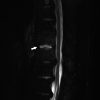
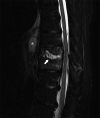
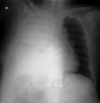

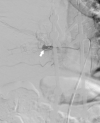

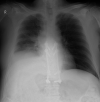
Similar articles
-
Massive hemothorax caused by intercostal artery pseudoaneurysm:a case report.J Cardiothorac Surg. 2021 May 31;16(1):156. doi: 10.1186/s13019-021-01548-1. J Cardiothorac Surg. 2021. PMID: 34059107 Free PMC article.
-
Contained rupture of the aneurysm of common iliac artery associated with pyogenic vertebral spondylitis.Spine (Phila Pa 1976). 2001 Jul 1;26(13):E303-7. doi: 10.1097/00007632-200107010-00027. Spine (Phila Pa 1976). 2001. PMID: 11458171
-
Occipital Artery to Anterior Inferior Cerebellar Artery (AICA) Bypass for Treatment of a Ruptured Proximal AICA-Posterior Inferior Cerebellar Artery Mycotic Aneurysm.World Neurosurg. 2020 Oct;142:176-178. doi: 10.1016/j.wneu.2020.06.090. Epub 2020 Jun 23. World Neurosurg. 2020. PMID: 32585380
-
An infected aneurysm of the vertebral artery following cervical pyogenic spondylitis: a case report and literature review.BMC Musculoskelet Disord. 2021 Jan 6;22(1):22. doi: 10.1186/s12891-020-03881-3. BMC Musculoskelet Disord. 2021. PMID: 33407352 Free PMC article. Review.
-
A rare case of spontaneous intercostal artery pseudoaneurysm rupture and literature review.Am J Emerg Med. 2025 Sep;95:290.e5-290.e7. doi: 10.1016/j.ajem.2025.06.006. Epub 2025 Jun 5. Am J Emerg Med. 2025. PMID: 40514248 Review.
Cited by
-
Diagnostic and therapeutic challenges of Candida albicans infection post-lumbar surgery in a rheumatoid arthritis patient: A case report and review of the literature.Medicine (Baltimore). 2025 Jul 25;104(30):e42970. doi: 10.1097/MD.0000000000042970. Medicine (Baltimore). 2025. PMID: 40725965 Free PMC article. Review.
-
Management of intercostal artery pseudoaneurysm following posterior pedicle screw insertion: illustrative case.J Neurosurg Case Lessons. 2025 Jan 27;9(4):CASE24291. doi: 10.3171/CASE24291. Print 2025 Jan 27. J Neurosurg Case Lessons. 2025. PMID: 39869887 Free PMC article.
-
Massive Hemothorax due to a Rare Entity: Dilemma of ICD Insertion!! A Case Report.Ann Card Anaesth. 2025 Jan 1;28(1):76-79. doi: 10.4103/aca.aca_135_24. Epub 2025 Jan 24. Ann Card Anaesth. 2025. PMID: 39851154 Free PMC article.
References
Publication types
MeSH terms
LinkOut - more resources
Full Text Sources
Medical

